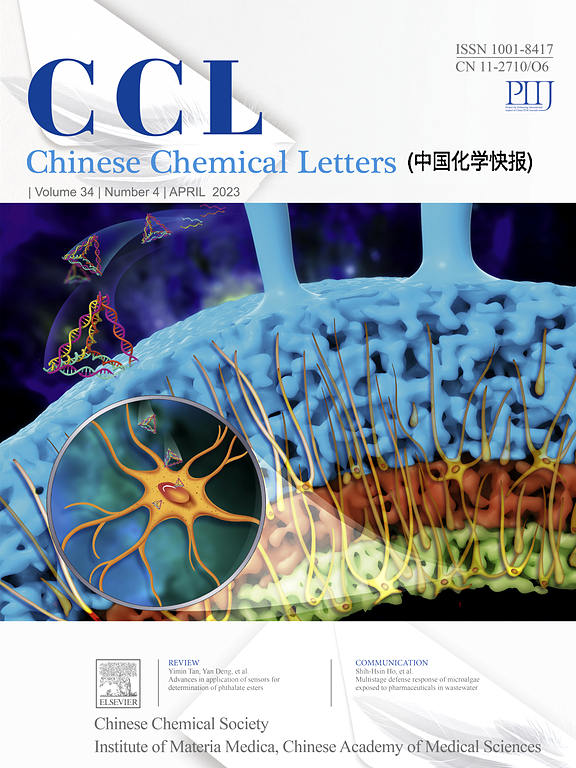Selective encapsulation of azo compounds by tetracationic cyclophane in water and photo-controlled reversible release
IF 9.4
1区 化学
Q1 CHEMISTRY, MULTIDISCIPLINARY
引用次数: 0
Abstract
Many azo compounds and their intermediates are toxic and have been linked to various health issues, representing a growing global problem. Molecular engineering for selective encapsulation of azobenzene compounds is critical, given their significant use in smart materials and prevalence as environmental micropollutants released from the food and dye industries. However, the current host molecules catering to azobenzene compounds are mainly limited to cyclodextrins, pillar[n]arenes and cucurbit[n]urils, demonstrating a moderate affinity. This report describes that a novel 3,3′-bipyridinium-based cyclophane was capable of encapsulating anionic azobenzene compounds in water with high binding affinity and pH stability through electrostatic attraction-enhanced mechanism, surpassing the extensively reported supramolecular systems. 1D&2D NMR experiments, UV–vis spectrum, X-ray crystallography and computational modeling were carried out to understand the host-guest complexation. It's worth noting that the tetracationic cyclophane exhibited good selective and anti-interference encapsulation properties in binary, ternary and seawater systems. Furthermore, upon UV/white light irradiation, the reversible conversion between (E)-4,4′-azobisbenzoate and (Z)-4,4′-azobisbenzoate triggers the dissociation/recomplexation of the host-guest complex within 3 min. This reversible photo-switchable (E)-disodium 4,4′-azobisbenzoate-BPy-Box4+ supramolecular system holds promise for designing novel materials for extraction/release of azo compounds and other small smart materials.

偶氮化合物在水中的选择性包封和光控可逆释放
许多偶氮化合物及其中间体是有毒的,与各种健康问题有关,是一个日益严重的全球性问题。考虑到偶氮苯化合物在智能材料中的重要应用以及作为食品和染料工业释放的环境微污染物的普遍存在,选择性包封偶氮苯化合物的分子工程至关重要。然而,目前偶氮苯类化合物的宿主分子主要局限于环糊精、柱[n]芳烃和葫芦[n]urils,表现出中等的亲和力。本文描述了一种新型的3,3 ' -联吡啶基环烷能够通过静电吸引增强机制将阴离子偶氮苯化合物包封在水中,具有高结合亲和力和pH稳定性,超越了广泛报道的超分子体系。通过二维核磁共振实验、紫外-可见光谱、x射线晶体学和计算模型来了解主客体络合作用。值得注意的是,四聚环烷在二元、三元和海水体系中均表现出良好的选择性和抗干扰性。此外,在紫外光/白光照射下,(E)-4,4′-偶氮苯甲酸酯和(Z)-4,4′-偶氮苯甲酸酯之间的可逆转化在3分钟内触发主-客体配合物的解离/再络合。这种可逆光切换(E)-4,4′-偶氮苯甲酸二钠- bpybox4 +超分子体系有望设计用于偶氮化合物提取/释放的新型材料和其他小型智能材料。
本文章由计算机程序翻译,如有差异,请以英文原文为准。
求助全文
约1分钟内获得全文
求助全文
来源期刊

Chinese Chemical Letters
化学-化学综合
CiteScore
14.10
自引率
15.40%
发文量
8969
审稿时长
1.6 months
期刊介绍:
Chinese Chemical Letters (CCL) (ISSN 1001-8417) was founded in July 1990. The journal publishes preliminary accounts in the whole field of chemistry, including inorganic chemistry, organic chemistry, analytical chemistry, physical chemistry, polymer chemistry, applied chemistry, etc.Chinese Chemical Letters does not accept articles previously published or scheduled to be published. To verify originality, your article may be checked by the originality detection service CrossCheck.
 求助内容:
求助内容: 应助结果提醒方式:
应助结果提醒方式:


